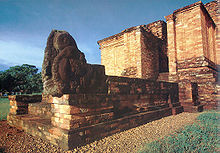Jambi (city)
| Jambi | |
|---|---|
| Basic data | |
| State : | Indonesia |
| Province : | Jambi |
| Coordinates : | 1 ° 35 ' N , 103 ° 36' E |
| Residents : | 457.005 |
Jambi is the capital of the Jambi province of the same name in Sumatra , Indonesia .
Sometimes the city is shown on maps under the name Telanaipura , which was introduced after independence . According to calculations in 2010, Jambi had 457,005 inhabitants. The population is essentially composed of Javanese , Sundanese , Bugis and Chinese .
The city is located on the Batang Hari , the longest river in Sumatra, 155 kilometers of river and about 90 kilometers inland as the crow flies. There is a large market at the pier for passenger ships, west of the Sungai Asam, which flows into the Batang Hari . It supplies the population with fresh goods.
Industrially, the point of view is important to the region insofar as the focus of production is on oil and rubber products . In addition, there are many paper mills, which, in cooperation with the tree processing industry, which is sometimes illegally cleared, endanger the ecological balance of the rainforest.
Sultan Taha Airport (DJB), named after the ruler deposed in 1858 , is located in Paalmerah, 4.5 km away .
history
The village was the residence of the Sultan of Jambi . A first Faktorei the VOC was built 1616th After the suppression of the uprising of 1901-07, the city became the administrative seat of the district of the same name under a resident . 38,311 people lived there in 1913, 957 of whom were Chinese, 468 Arabs, 70 Europeans and 37 other foreigners. In the city itself, which consisted of 12 villages ( kampong ), there were 7343 inhabitants (727 Chinese, 263 Arabs, 35 Asian foreigners, 63 Europeans), plus a garrison of 150 soldiers and 240 police officers. The administrative district was 17,295 km². By November 1920, the city's population rose to 11,311; among them were 132 Europeans and 1,847 Chinese. 46,777 people lived in the district. The city was divided by the river, along the right bank was the European quarter, on the left the locals lived, spread over 18 hamlets.
The Candi Muaro Jambi Complex
The Candi Muaro Jambi is a special attraction . This is a Buddhist temple complex, which is about 25 km east of Jambi and was a metropolis of the Srivijaya commercial empire between the 11th and 13th centuries . The temple complex is the largest archaeological site on Sumatra, comprising a total of eight excavated temple sanctuaries, including, for example, the Candi Tinggi , the Candi Kedaton or the Candi Gumpung , covering an area of around 12 km². The area stretches over 7.5 km along the Batang Hari, on which there are other, unexcavated temples overgrown by dense jungle thickets. Further excavations are currently being carried out, financed solely by the Indonesian government; seven of 82 temple buildings have already been exposed. Artificial canals, once created for ritual and practical reasons, connect the complex with the river. It is expected in the region that the architectural legacy of early Buddhism will soon be a UNESCO World Heritage Site.
The temples are made of red brick and, in contrast to the Javanese temples, have little ornamentation in the form of carvings or sculptures.
Town twinning
-
 Kupang , Indonesia
Kupang , Indonesia -
 Nakhon Ratchasima , Thailand
Nakhon Ratchasima , Thailand -
 Ermera , East Timor
Ermera , East Timor -
 Ainaro , East Timor
Ainaro , East Timor
More Attractions
- Orchid farm with up to 170 different orchid species
- Provincial Museum - local museum of the region
- Jambi batik - a textile painting art from Indonesia that is popular and famous all over the country
- Rumah Adat Jambi - the replica of a traditional house in Taman Mayan Mangurai Park
- Harapan rainforest
Others
- The city's supply airport , Paalmerah , is less than 5 km away . Sultan Thaha Airport is located in the city .
- Jambi University was founded in 1963 .
Individual evidence
- ↑ Archived copy ( Memento of the original dated December 29, 2011 in the Internet Archive ) Info: The archive link was automatically inserted and not yet checked. Please check the original and archive link according to the instructions and then remove this notice.
- ^ A b Michael Lenz: Tempelstadt: Das “Angkor Sumatras” , Spektrum.de, accessed on May 24, 2012
- ^ Pieter A. van der Lith (Ed.): Encyclopaedie van Nederlandsch-Indië; s'Gravenhage ² 1917; Volume 1, p. 614; Article "Djambi"
- ↑ Pieter A. van der Lith (Ed.): Encyclopædie van Nederlandsch-Indië; s'Gravenhage 1927; Volume 5, pp. 139-142, article "Djambi".
- ^ Dominik Bonatz, John David Neidel, Mai Lin Tjoa-Bonatz: The Megalithic Complex of Highland Jambi. An Archaeological Perspective. In: Bijdragen tot de Taal-, Land- en Volkenkunde 162-4, 2006, pp. 490-522
- ↑ Candi Muara Jambi: Sumatra's lost temple city on evangelisch.de ( page no longer available , search in web archives ) Info: The link was automatically marked as defective. Please check the link according to the instructions and then remove this notice. Retrieved May 24, 2012
- ↑ Annika Natus, Hope for Tiger and Tapir, The new major project Harapan in Indonesia ( Memento of the original from September 2, 2012 in the Internet Archive ) Info: The archive link has been inserted automatically and has not yet been checked. Please check the original and archive link according to the instructions and then remove this notice.



